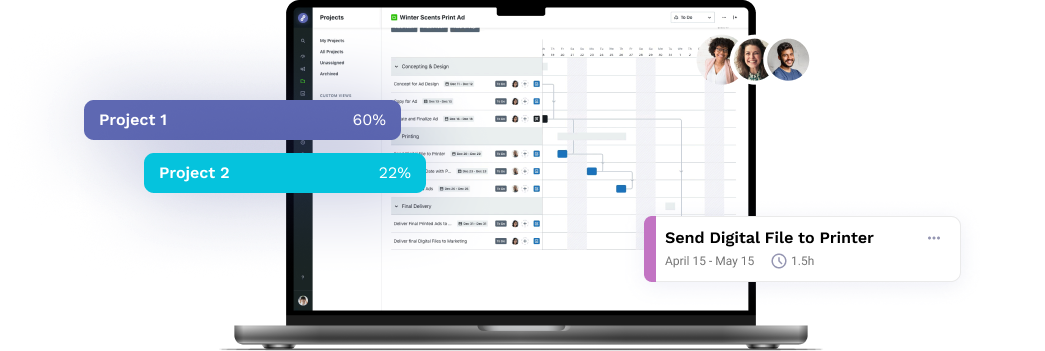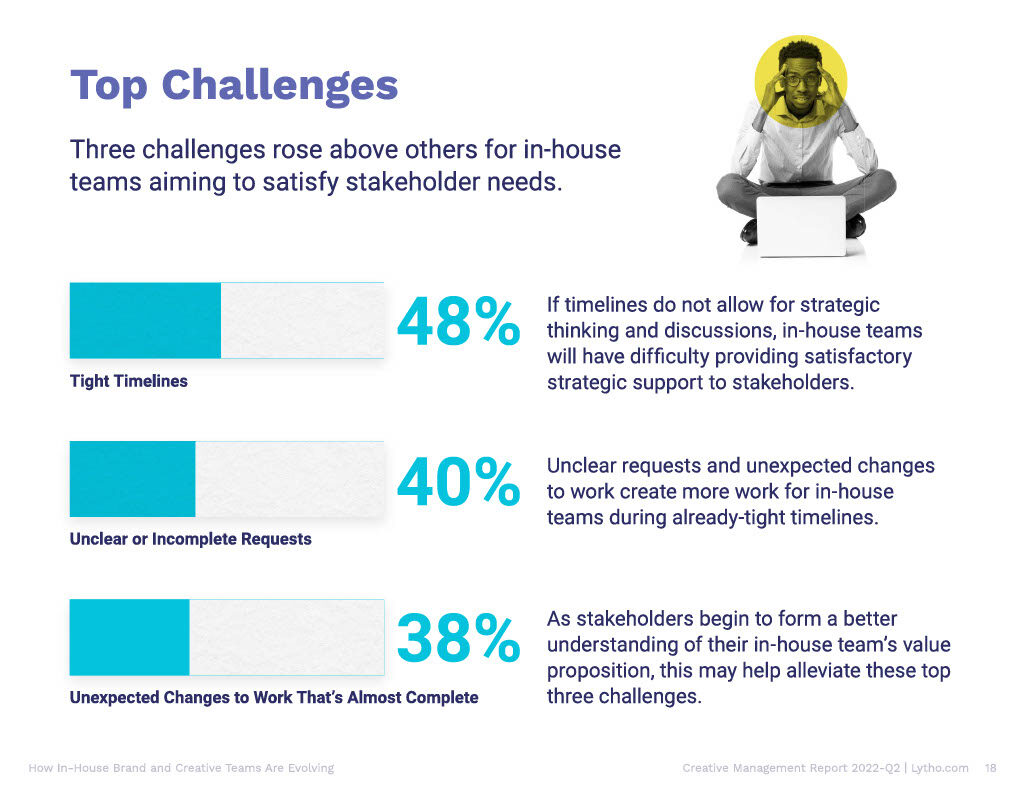
How you approach request intakes may determine the success, or lack thereof, of your entire project. Having the right creative request intake process in place is crucial to kicking things off on the right foot. Read on to learn how to create a comprehensive and collaborative request intake process, so you can start your projects faster.
Top 3 Challenges of Lacking a Clear Request Intake Process
The process has as many names as it does stakeholders. Whatever you want to call it, requesting work from the creative team is a pivotal point in project workflow, that can determine the success or failure of a project. It is also one of the most challenging aspects of the creative workflow:
In the infographic below, taken from our 2022 Q2 Creative Management Report, 40% of creative teams reported that the lack of an unclear and incomplete request intake process is the second biggest challenge that creative teams are being called to face on top of their mounting, pile-high workloads.
Great Collaboration Produces Excellent Creative Assets
In many ways, this first step in the creative workflow should be the most collaborative step. Unfortunately, many stakeholders view the creative briefing process as a hassle and a formality that they often race through. However, for creative teams to produce impactful creative assets, they need a complete brief on the following:
- The full scope of the larger campaign
- All desired outcomes for the project
- The problems the initiative is trying to solve
When creative teams receive incomplete briefs and do not participate in conversations with those putting in the requests, the entire creative workflow is in jeopardy. You can tie most problems along the way back to an inadequate project kickoff. This can look like:
- A difficult proof review with lots of negative feedback
- An excessive revision loop that feels never-ending
The above are indicators of a gap between what the requester expected and what they outlined in the brief.
This lack of collaboration during project kickoff is a direct indicator of creative teams being viewed as order takers, rather than collaborative partners. Let us look at what the ideal creative briefing and request intake process should look like.
The Ideal Request Intake Process
The ideal request intake process begins with the brief.
Step 1: Have a Comprehensive Creative Brief
The term “creative brief” describes a document that lists out all the requirements for the project. This should include everything from technical specifications to concept and design notes. It should include timeline information such as a due dates, and all relevant reference materials. Creative briefs are not “job tickets” or “order forms”. They are documents that you can use to kick off the process of requesting work. You can do so by documenting the needs of the project so that you can easily distribute and review them throughout the project.
Step 2: Review the Creative Brief Received
The form submission should not automatically generate work. Many generic project management solutions tout automatically generating work from submitted requests. This is the difference between generic PM and creative workflow management. Creative teams need an opportunity to control incoming requests.
They need to review and approve requests before they can accept them. Is the due date realistic? Did the requester provide all the information the creative team needs to get started on the project? Does the creative team understand the context surrounding the project, and what metrics will measure the success of the project?
Sometimes, requesters provide all this information in the initial submission, so creative teams can easily accept them. Other times, if a project is more complex or the requester has been less fastidious with their submission, the creative team may need to collaborate with the requester before work can begin. The creative team must be allowed to decline incomplete and unrealistic requests. By sending the brief back to the requester, you allow for the right changes to be made before work can begin.
Request sharing is one of the more important parts of a collaborative request intake.
Being able to share access to submitted requests with other team members or stakeholders increases transparency and invites cross-departmental collaboration.
Finally, have a good request intake process under a single dashboard. This is how you can improve your project’s entire lifecycle. Requesters can use this dashboard to:
- Check on the status of their work
- Collaborate with the creative team in a dedicated space
- Retrieve final deliverables
When you share the request dashboard, your stakeholders can also access the project’s final deliverables. Even when you and your creative team complete and file a project, the requester will still be able to view it. So when you have to do similar work next quarter or next year, both your requesters and your creative team can refer to this filed request to speed things up.
What to Look For
If your creative team wants to find opportunities to improve the request intake process by implementing a creative workflow management solution, ask these three questions of any software you evaluate:
- How does the system treat creatives?
- Is the creative team given control over the process?
- What opportunities does the software provide that increases transparency with stakeholders?
- Does the entire request process sync with the rest of the platform, or does it feel like an afterthought?
Read More on Creative Briefing:
What Is a Creative Brief? How Can You Write an Effective One?
Dynamic Form Template Builder: Revolutionize Your Creative Briefing Process
Lytho helps you streamline your entire workflow and harmonize all brand collateral under a single, uniform platform. Feel free to reach out to us by scheduling a demo and learning how our creative solutions can boost the effectiveness of your creative projects. We look forward to speaking with you!
Do you want to give yourself and your creative team more room for creative stimulation by automating the boring stuff? Lytho helps you streamline your entire workflow and harmonize all brand collateral under a single, uniform platform. Feel free to reach out to us by scheduling a demo and learning how our creative solutions can boost the effectiveness of your creative projects. We look forward to speaking with you!

Ready to simplify your creative operations and start having a little fun at work again? Schedule time to talk with us.
Let us show you how Lytho’s Creative Operations Platform helps in-house creative and marketing teams do better work, ease the stakeholder experience, and stay on brand.
Schedule a Demo